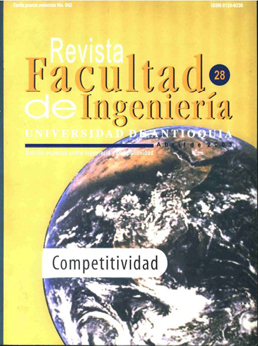Retos en la aplicabilidad de la norma colombiana sobre el control de dioxinas y furanos en incineradores
DOI:
https://doi.org/10.17533/udea.redin.326421Keywords:
Dioxinas, furanos, análisis, cromatografía de gases (CG)/espectrometría de masas (MS), normas ambientales.Abstract
Los incineradores de desechos hospitalarios, municipales y hornos crematorios se han identificado como los principales generadores de dioxinas y furanos. Colombia no ha sido ajena a esta problemática. Recientemente, el Ministerio del Medio Ambiente estableció las pautas para regular las emisiones de incineradores de residuos sólidos y líquidos. La forma más directa de conocer el estado actual y la eficiencia de los sistemas de control que se implementen para cumplir con las normas es mediante el análisis de estas sustancias. Los análisis de dioxinas y furanos en muestras de cenizas de un incinerador de residuos hospitalarios de la ciudad de Medellín ilustran la metodología analítica establecida por organismos internacionales para la detección y cuantificación de dioxinas y furanos. Dado que los costos implicados en dichos análisis son demasiado altos, se requieren estrategias que faciliten el cumplimiento de la norma.Downloads
References
Casanovas, J., Ramos Rivero, L., et al. "Dioxinas y furanos problemática ambiental y metodologia analítica". Ministerio de Obras Públicas, Transportes y Medio Ambiente, Madrid. 1996. pp. 1-268.
Overmeire I.V., Clark G., et al. "Trace contamination with dioxin-Like chemicals: evaluation of bioassay-based TEQ determination for hazard assessment and regulatory responses", Env. Sci & Policy, Vol. 4, 2001, p. 345. DOI: https://doi.org/10.1016/S1462-9011(01)00037-5
McKay G. "Dioxin Characteristion, formation and minimisation during municipal solid waste (MSW) incineration: review", Chem. Eng. J. Vol. 86. 2002. P. 343. DOI: https://doi.org/10.1016/S1385-8947(01)00228-5
Ministerio del Medio Ambiente, Colombia. "Resolución 0058: Normas y límites máximos permisibles de emisión para incineradores y hornos crematorios de residuos sólidos y líquidos, artículo 7 límite de emisión de dioxinas y furanos". Enero, 2002.
Mukerjee D. "Health impact of polychlorinated Dibenzo-p-dioxins: A critical review". J. Air & Waste Manage. Assoc. Vol. 48. 1998. p. 157. DOI: https://doi.org/10.1080/10473289.1998.10463655
Mukerjee D. "Health risk of endocrine-disprupting ortho-substituted PCBs". Enviromental Engineerig Science. Vol. 15. No. 2. 1998. p. 157. DOI: https://doi.org/10.1089/ees.1998.15.157
Lovett A.A., Foxall C.D. and Chewe D. "PCB and PCDD/DF concentrations in egg and poultry meat samples from know urban and rural locations in Wales and England". Chemosphere. Vol. 37. 1998. p. 1.671. DOI: https://doi.org/10.1016/S0045-6535(98)00233-1
Abad E. "Estudio de las políclorodibenzo-p-dioxinas (PCDF) y los policlorodibenzofuranos (PCDF) en los procesos de incineración y su influencia en el medio ambiente". Tesis Doctoral Universidad de Barcelona Facultad de Química, Barcelona. 1999. pp. 1-254.
U.S. Environmeotal Protectioo Agency, office of water. "Method 1613: Tetra through octa-chlorinated dioxins and furans by isotope dilution HRGC/HRMS". Octubre de 1994.
U.S. Environmeotal Protection Agency. "Method 8290A: Polychlorinated Dibenzodioxins (PCDD) and Polychlorinated Dibeozofurans (PCDF) by HRGC/HRMS". Enero de 1998.
U.S. Environmental Protection Agency. "Method 8280A: The analysis of Polychlorinated Dibeozodioxins and Polychlorinated Dibenzofurans by high resolution gas chromatography/low resolution mass spectrometry (HRGC/LRMS)". Diciembre de 1996.
U.S. Environmental Protection Agency. "Method 23 EPA, part 60: Determination of Polychlorinated Dibenzodioxins and Polychlorinated Dibenzofurans from stacionary sources". Julio de 1994.
Comunidad Económica Europea. "Método EN 1948 1-2-3: Stationary source emissions determination of the mass concentration of PCDD/PCDF". Diciembre 1996.
U.S. Environmental Protection Agency. "Compendium of methods for the determination of toxic organic compounds in ambient air TO-9A: Determioation of polychlorinated, polybrominated and brominated/chlorinated dibenzo-p-dioxins and dibenzofurans in ambient air". Enero 1997.
Eljarrat E., Casanovas J., et al. "Determination of chlorinated dioxins and furans by high resolution gas chromatography coupled to mass spectrometry: comparative study of LRMS and HRMS". Química Analítica. Vol. 14. 1995. p. 89.
Hayward D.G., Hooper K. and Andrzejewski D. "Tandem-in-time mass spectrometry method for the sub-parts-per-trillion determination of 2, 3, 7, 8- chlorine-substituted dibenzo-p-dioxins and -furans in high-fat foods". Anal. Chem. Vol. 71. No. l. 1999. p. 212. DOI: https://doi.org/10.1021/ac980282+
Fabrellas B., Saoz P., et al. "Análisis of PCDD/PCDF by ion trap detector. Application to waste samples", Organohalogen Compounds. Vol. 45. 2000. p. 160.
Abad E., Sauló J., et al. "Evaluation of a new automated cleanup system for the analysis of polychlorinated dibenzo-p-dioxios and polychlorinated dibenzofurans in environmental sample". Journal of chromatography A. Vol. 893.2000.p.383. DOI: https://doi.org/10.1016/S0021-9673(00)00760-3
Abad E., Adrados M. A. et al. "Dioxin abatement strategies and mass balance at a municipal waste management plant", Environ. Sci. Technol. Vol. 36, 2002. p. 92. DOI: https://doi.org/10.1021/es010039j
Downloads
Published
How to Cite
Issue
Section
License
Revista Facultad de Ingeniería, Universidad de Antioquia is licensed under the Creative Commons Attribution BY-NC-SA 4.0 license. https://creativecommons.org/licenses/by-nc-sa/4.0/deed.en
You are free to:
Share — copy and redistribute the material in any medium or format
Adapt — remix, transform, and build upon the material
Under the following terms:
Attribution — You must give appropriate credit, provide a link to the license, and indicate if changes were made. You may do so in any reasonable manner, but not in any way that suggests the licensor endorses you or your use.
NonCommercial — You may not use the material for commercial purposes.
ShareAlike — If you remix, transform, or build upon the material, you must distribute your contributions under the same license as the original.
The material published in the journal can be distributed, copied and exhibited by third parties if the respective credits are given to the journal. No commercial benefit can be obtained and derivative works must be under the same license terms as the original work.










 Twitter
Twitter